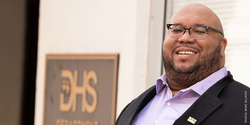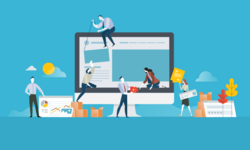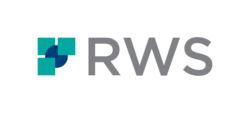Search results for 'Michael Emery'
Displaying
23 Items
Categories
Article
2
Blog
5
People
4
Performance Resource
1
Webinar
11
Refine By
Displaying
23 Items
Mission control
By Michael Emery on 1 Jul, 1996
Nick Craig
Nick co-authored "Finding Your True North" with Bill George of Harvard Business School and is President of the Authentic Leadership Institute. He is a Wharton Aresty Fellow and also teaches in senior leadership programs. Beyond his involvement with Authentic Leadership, Nick has worked with Michael Beer, Director Emeritus of Harvard Business School’s Organizational Change practice, helping top teams have honest dialogues that drive strategic implementation. Additionally, he has worked with MIT’s Sloan School to develop their Leadership Center and executive coaching program based on the Distributed Leadership Model.

Dedicated to Serving
CLO Michael Dorsey ensures that every Department of Human Services employee has the training they need to serve Maryland residents.
By Ryann K. Ellis on 15 Jul, 2020
Michael O'Connell
Michael O'Connell is vice president of clinical and support services for Marymount Hospital, a Cleveland Clinic hospital, in Garfield Heights, Ohio. He is responsible for hundreds of employees in the departments of radiology, lab, cardiopulmonary services, pharmacy, security, emergency management, and facilities. Michael oversees services at three campuses; serves as the corporate compliance official, safety officer, and environment of care chairman; and is responsible for all construction and renovation projects. He is executive sponsor for the hospital’s Green Team and Helping Hands Committee. Prior to his current position, Michael served in various leadership roles at Cleveland Clinic for 15 years, including vice president of clinical services, vice president of operations and physician services, vice president of professional and physician services, and senior director. Michael has a master of health administration degree from Saint Louis University and a bachelor of science degree from University of Illinois, Urbana. He is certified in healthcare management and medical practice and is a fellow in the American College of Medical Practice Executives and American College of Healthcare Executives.

E-Learning for Everyone: How to Address Accessibility
An understanding of the need for better online accessibility has grown markedly in recent years, perhaps accelerated by the digital shift during the COVID-19 lockdowns in 2020. Legislation in different parts of the world has also been a driver of awareness and action.Accessible learning is good for everyone.As an online activity, e-learning falls squarely within the scope of accessibility requirements. But whether you’re responding to a compliance deadline, pressure from customers, or a corporate commitment to diversity and inclusion, it’s well worth noting that designing training with accessibility in mind can enrich the learning experience for everyone, not just those with a defined disability. So, accessibility should be a priority for any L&D professional who wants to optimize the learning experience.Where to start?Unless your strategy is to invest in your own in-house accessibility expertise, the natural first step is to find the right partner to advise and assist you.First, they should understand the requirements of any legislation you need to comply with. Second, if you’re interested in more than compliance—because, let’s face it, ticking compliance boxes is not always the same as taking a best-practice approach— they’ll be able to explain different standards and what you could be doing to transform learning through accessibility improvements. There’s a difference, for example, between a basic screen reader experience, which may be good enough for compliance, and a great screen reader experience, which makes a real difference for usability.Third, they should be able to help you develop a roadmap and a plan to achieve your e-learning accessibility objectives.Consider remediation from the start.Every respectable accessibility improvement plan starts with an audit against the relevant standards to establish what accessibility gaps exist. Once these are identified, the next step is remediation—fixing the identified accessibility issues—so it’s worth considering from the start whether you want your accessibility partner to help you with this.If you’re happy to handle remediation in-house or through a different partner, then it won’t matter if the accessibility specialist you choose doesn’t have specific expertise with e-learning platforms, hosted assets, and content formats. But if you do expect to need their remediation support, it can be a big advantage if they are also e-learning specialists. Consider this carefully before making your choice—and don’t forget that accessibility covers both your e-learning platform and the training content that it holds.Consider the impact of localization.Hopefully, localization is part of your e-learning strategy, since L&D has a greater chance of success when it happens in the learner’s native language. But this means that accessibility testing must cover all the languages you localize into. Even if you’re applying the same accessibility standards across countries and languages (legislative differences may mean this isn’t the case), it simply doesn’t follow that if your e-learning is accessible in one language, it will automatically be accessible in any other.For example, what if your e-learning platform doesn’t accept voice commands in all of the languages you cater to? Or, what if the way you’ve handled forced line breaks for certain Asian languages causes real trouble for screen readers?When you’re choosing an accessibility partner, make sure that they cover all of the languages you need. If they’re helping you with remediation, they also need to know coding best practices that address the user experience from both a localization and accessibility point of view—not compromising one for the sake of the other.Another way that localization and accessibility can go hand in hand is that the right localization partner can make a big difference to your accessibility journey. For example, video accessibility might feel like a big hurdle to clear, but it isn’t if your localization partner also offers (multilingual) accessible content services such as closed captions, signed videos, audio descriptions, and descriptive transcripts.It's an ongoing process.E-learning accessibility isn’t a one-off project that you complete and forget. It takes continuing vigilance and an accessibility-first approach to platform and content development. Otherwise, improvements you make will be undone over time.If you use a third-party e-learning platform or rely on e-learning vendors for course design and development, you’ll need to engage with them to achieve your accessibility objectives. If you do any of this in-house, you’ll need to update your own software standards, guidelines, and checklists, and educate your software engineers and learning designers to put accessibility front and center.There’s certainly a lot to get right when it comes to e-learning accessibility. But that doesn’t mean it needs to be painful. Help exists to make the complex more controllable and achievable. I hope I’ve inspired you to get started.
By Michael Coates on 19 Dec, 2024

7 ChatGPT & Copilot Hacks Every L&D Pro Must Know
Join bestselling author Mike Song in this dynamic and engaging webinar as he demonstrates how to harness AI tools like ChatGPT and Copilot to revolutionize content creation. When an unexpected challenge arises, watch as Mike uses AI to craft a class, workbooks, and even a song live! Master great prompts and discover incredibly useful shortcuts that save L&D professionals up to two hours a day while boosting content quality. Transform your workflow and ignite creativity in this unforgettable session. During this event, you will: Discover advanced AI applications tailored to enhance L&D workflows and elevate training outcomes. Master techniques for creating and storing precise prompts to streamline content creation and save valuable time. Unlock innovative ways to expand creativity and deliver meaningful learning experiences using AI-powered tools. Primary Capability Covered: Technology Application Participation in this event, either live or recorded, can be reported for one (1) professional development point toward initial certification or recertification requirements for the APTD or CPTD credential.
28 Jan, 2025

How to Guarantee Manager Buy-In for Every Global Training Program
By Sardek Love on 10 Aug, 2016
4 Minimum Authorities that Every Manager Must Have
By Michael Cardus on 29 Nov, 2012
Michael Hruska
President/CEO
Michael Hruska is president and chief executive officer of Problem Solutions. He is a technologist and design thinking (DT) practitioner with experiences spanning across standards, emerging technologies, learning, and science. He is a former researcher at the National Institute of Standards and Technology (NIST). Mike provides technology, business model and innovation solutions to Fortune 500, Government and startup companies. He researches, strategizes, designs, and makes advanced technology solutions and products. His team has built award winning products and delivered solutions that support millions of users and billions of hits of daily web traffic. Michael’s experience spans the continuum between advanced research on adaptive learning ecosystems and emerging technology solution/product design in a variety of industries.Michael is a member of the e-Learning Guild, the Association for Training and Development (ATD), the Society for Applied Learning Technologies (SALT), and the National Defense and Industrial Association (NDIA) and regularly presents at industry events.



